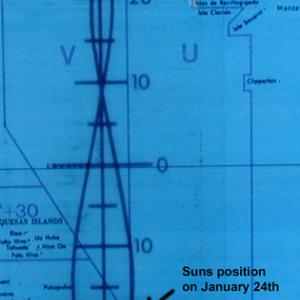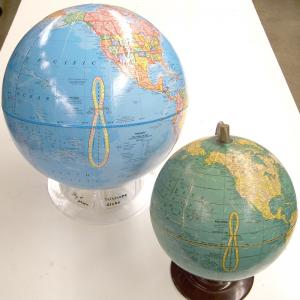College of Liberal Arts & Sciences
8A10.80 - Analemma
See also Geochron 1A10.41 in Mechanics and Geochron/Analemma 1A10.41/8A10.80 in Astronomy.
Although there are methods of plotting solar position verses Earth's position, this usually takes one year for a full cycle. For practical purposes we use the built in chart on the Geochron or ones on the two Earth globes shown. Position verses date can be observed there.
NOTE: Not every Earth globe has the Analemma printed on it. In that sense, these two globes are special and should not be lost, discarded, or removed from Rm. 58 Van.
- Leslie Atkins Elliot, Amanda Hunter, Carl Krutz, ShaKayla Moran, Elliot Sherrow, "Stop-Motion Animation to Model the Analemma", TPT, Vol. 59, #4, April 2021, p. 230.
- Alejandro Gangui, Cecilia Lastra, and Fernando Karaseur, "On Times and Shadows: The Observational Analemma", TPT, Vol. 56, #6, Sept. 2018, p. 367.
- William Baird, Jeffery Secrest, Clifford Padgett, Wayne Johnson, and Claire Hagrelius, "Smartphones and Time Zones", TPT, Vol. 54, #6, Sept. 2016, p. 351.
- Philip M. Sadler and Christopher Night, "Daytime Celestial Navigation for the Novice", TPT, Vol. 48, #3, Mar. 2010, p. 197.
- Prabasaj Paul, "Analemma", TPT, Vol. 39, #5, May 2001, p. 265.
- Dan M. Davis, "An Analemma Experiment", TPT, Vol. 38, #9, Dec. 2000, p. 570.
- James Brimhall, "The Varying Lengths of Solar Days", TPT, Vol. 34, #6, Sept. 1996, p. 351.
- R. H. Garstang, "Sunrise and Sunset", TPT, Vol. 34, #5, May 1996, p. 260.
- Mary Lou West and Jo‐Linda Keith, "Sunrise Surprise", TPT, Vol. 34, #1, Jan. 1996, p. 58.
- Jennifer Hickman and Robert Mitchell, "Determination of the Subsolar Point or (Where on Earth Is the Sun?)", TPT, Vol. 29, #5, May 1991, p. 318.
- D. Easton, "On the Sun, Earth, and Clocks", TPT, Vol. 23, #2, Feb. 1985, p. 85.
- Joseph S. Chalmers, "Ground Trajectories of Geosynchronous Satellites and the Analemma", AJP, Vol. 55, #6, June 1987, p. 548.
- D. Tattersfield, "5.8, The Analemma", Project & Demonstrations in Astronomy, p. 89.
Disclaimer: These demonstrations are provided only for illustrative use by persons affiliated with The University of Iowa and only under the direction of a trained instructor or physicist. The University of Iowa is not responsible for demonstrations performed by those using their own equipment or who choose to use this reference material for their own purpose. The demonstrations included here are within the public domain and can be found in materials contained in libraries, bookstores, and through electronic sources. Performing all or any portion of any of these demonstrations, with or without revisions not depicted here entails inherent risks. These risks include, without limitation, bodily injury (and possibly death), including risks to health that may be temporary or permanent and that may exacerbate a pre-existing medical condition; and property loss or damage. Anyone performing any part of these demonstrations, even with revisions, knowingly and voluntarily assumes all risks associated with them.

